Pioneer Species - Re-establishing Woodland
We hear lots of reports about the destruction of the tropical rainforests, yet few people seem to realise that huge areas of Britain were deprived of their tree cover many centuries ago. It seems difficult to imagine when you travel in the countryside nowadays, but until humans arrived in Britain 97% of the country used to be covered in forest!
Forest clearance began with the need for fuel coupled with the desire for grazing and arable land as humans turned from hunter/gatherers to farmers. It gradually gathered pace as the human population grew and the need for wood increased, firstly for construction, ship building etc. and later for fuelling the industrial revolution.
With modern machinery it takes just a few minutes to chop down a tree that might have been growing for several hundred years. Remove all the trees in an area and it can become very difficult for them to re-establish themselves, especially if the land is exposed such as near the coast or at higher elevations. Yet trees are the natural vegetation for almost all of Britain and without them they will lose much of the wildlife as well as causing environmental destruction in the form of soil erosion, flooding etc.
In the winter of 1990 -1991 the Ferns planted out almost 15,000 native trees on their very windswept site on the coast of Cornwall. Most grew satisfactorily, if rather slowly, and after five years averaged about 1.5 metres in height. However, there were huge differences between the different species with some still less than 1 metre tall and, at the other end of the scale, others were more than 5 metres tall.
Seeing these huge differences set them thinking about the way they were attempting to restore the tree cover on this site. Talking it over with a visiting Australian who designed permaculture sites in Australia and South America, they came to understand a little more about putting permaculture ideas into practice.
In conventional gardening there are certain species of plants just sitting there waiting to invade our freshly turned soil. These plants are either aggressively self-sowing, or they have aggressive root systems, or both. We call them weeds, but these are nature’s pioneers and some of her strongest survivors. Many of these plants are annuals or herbaceous perennials, and perhaps their seeds lie dormant in the soil for many years, buried too deep to be able to germinate. Digging the soil will have bought some of these to the surface where the light will stimulate germination. Others of these weeds will have very light seed that is carried by the wind and so can travel quite large distances in their search for suitable conditions to grow in. These plants will soon clothe the bare soil, protecting it from erosion and starting the process of regenerating it to its natural, or climax, vegetation. If you leave almost any land alone for sufficient time in Britain you will end up with a woodland growing there.
The Australian permaculturalist was taking advantage of this by deliberately introducing these pioneer species into his designs. However, instead of using these annuals and perennials, he would short-circuit the system by using those trees and shrubs that have the ability to invade land and act as pioneers. For example, if he was taking over a barren site, he would immediately plant it out with fast-growing leguminous trees. In his part of the world, these trees could grow 6 metres or more tall within 3 years of sowing the seed. By planting them fairly densely (at about 5 metre spacing), by the end of the first growing season he would have a mini woodland already 2 metres or more tall. Then, amongst these legumes he would start to plant out those species he really wanted to grow on the site. These plants would immediately start to benefit from the protection and the nitrogen that the legumes were providing.
By the end of the third year the new plantings would be established and growing away nicely. The site would be getting rather crowded and so he would start to cut down some of the fast-growing legumes, using the wood for fuel, construction or whatever and shredding everything that was left to be used as a mulch.
This is a marvellous method of restoring land to tree cover, especially in the more difficult situations where most woodland trees will struggle to survive, and it can also be used on a smaller scale to provide nourishment and protection for herbaceous plants. There are many species suitable for this in temperate climates, though don’t expect the same rates of growth that can be achieved in warmer climates.
When deciding on which species to use as pioneers, it is important to take all the characteristics of your land and the way you intend to use it into account, and also to understand the habits of the different pioneer plants. Looking firstly at the habits of the plants, species such as the alders (Alnus species) and sea buckthorns (Hippophae species) are very good companion plants that will enrich the soil around them and improve the growth of neighbouring plants. Thus these species are ideal for using in the way described above and can be planted in quite large quantities on the site. However, other species such as the poplars (Populus species) and willows (Salix species) have very vigorous root systems that will compete strongly with other plants. When using these as pioneers it is better to plant them in a more compact way such as a hedge or shelterbelt - this will soon provide shelter on the land for your other trees without creating competition problems. Other species, such as the sycamore (Acer pseudoplatanus) are more neutral in their effect on other species and can be used in small quantities dotted around the site, thus ensuring plenty of diversity. When detailing the species to be used as pioneers, they will be divided into these three sections.
The second important factor to take into account is the land and its intended use. For example, if you have a very poor soil then you are going to want to concentrate on species that will improve the soil condition - these will generally be those plants in the first section below. If you land is on a slope, and erosion is a problem, then you will need to look for those species with vigorous root systems. If you are close to the coast then you will probably need plants that can tolerate maritime exposure. If your land is quite high up then you might need to be looking for those species that will tolerate cold, strong winds.
There are many other factors to take into account here, but space does not allow it in this chapter. In the end it is up to your own judgement of the site - try not to rush this judgment but give yourself time to be with the land and come to understand its nature. If you feel that you do not have enough experience to do this, then try to enlist the help of a more knowledgeable gardener in your area - preferably someone with an understanding of permaculture.
Detailed below are a few of the trees and shrubs that make good pioneer species. This list is by no means exhaustive, but it does indicate the potential that exists.
The soil enrichers
(Those species that can be used in quantity and interplanted with your other trees.)
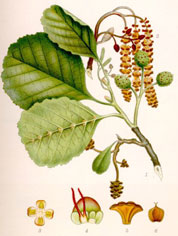 Alnus species. The alders are perhaps the best species that can be used as pioneers - they really have everything going for them. They are fast-growing even in severe exposure - we have had some species reach 6 metres in height within 5 years of sowing the seed. They enrich the soil with nitrogen and their heavy leaf-fall in the autumn greatly increases the humus content of the soil. They are short-lived, and their seedlings are unable to establish themselves in shady conditions - thus they will never hang around to make a nuisance of themselves once they have done their job. Any members of the genus can be tried, most of which require a moist to wet soil if they are to really thrive. Those species we especially recommend are:-
Alnus species. The alders are perhaps the best species that can be used as pioneers - they really have everything going for them. They are fast-growing even in severe exposure - we have had some species reach 6 metres in height within 5 years of sowing the seed. They enrich the soil with nitrogen and their heavy leaf-fall in the autumn greatly increases the humus content of the soil. They are short-lived, and their seedlings are unable to establish themselves in shady conditions - thus they will never hang around to make a nuisance of themselves once they have done their job. Any members of the genus can be tried, most of which require a moist to wet soil if they are to really thrive. Those species we especially recommend are:-
A. cordata. The italian alder tolerates drier soils than other members of the genus, it also holds on to its leaves later into the autumn, thus giving extra protection from autumn gales.
A. glutinosa. The British native alder is not as fast growing as some other members of the genus, but it can still reach 4 metres in height within 5 years. Being native, it has the added advantage of being more useful for wildlife. The alder is also a superb source of dye materials, with brown, red, green, pink, yellow and cinnamon hues being obtained.
A. rubra. The red alder grows amazingly quickly, even in extreme exposure. We have plants that have reached 7 metres in height within 5 years.
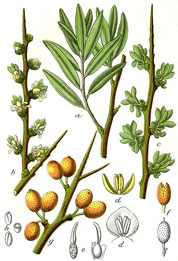 Hippophae species. This is another genus that is very useful for re-establishing woodland. The plants are, in general, fast-growing though they may take a year or two to get going. They enrich the soil with nitrogen and will succeed even in extreme maritime exposure. In addition their fruit is incredibly nutritious and has been shown to have a wide range of medicinal applications, including in the prevention and treatment of cancer. Many members of this genus sucker very freely and so are not suitable for small areas, though this suckering habit means that the plants are ideal for stabilizing sandy soils or steep slopes. This makes them ideal plants for providing shelter near the coast and they are some of the most wind-resistant species that we grow. For more information see the Plant Portrait - Hippophae about the plant. We would particularly recommend the following two species:-
Hippophae species. This is another genus that is very useful for re-establishing woodland. The plants are, in general, fast-growing though they may take a year or two to get going. They enrich the soil with nitrogen and will succeed even in extreme maritime exposure. In addition their fruit is incredibly nutritious and has been shown to have a wide range of medicinal applications, including in the prevention and treatment of cancer. Many members of this genus sucker very freely and so are not suitable for small areas, though this suckering habit means that the plants are ideal for stabilizing sandy soils or steep slopes. This makes them ideal plants for providing shelter near the coast and they are some of the most wind-resistant species that we grow. For more information see the Plant Portrait - Hippophae about the plant. We would particularly recommend the following two species:-
- H. rhamnoides. The British native sea buckthorn grows wild by the coast. The fruit is very sharp, but is exceedingly rich in vitamin C and makes an excellent preserve.
- H. salicifolia. The willow-leaved sea buckthorn is not hardy in the colder areas of the country, but where the climate suits it the plant will grow quickly and provide very good yields of fruit. This fruit is not as sharp as the native sea buckthorn, though it is still a strong lemon flavour. It can also be picked from mid-August and will hang on the tree until early winter.
-
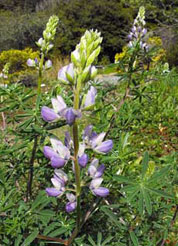 Lupinus arboreus. The tree lupin comes from California and is only hardy in the milder areas of temperate climates. In areas where it is suited, it makes an excellent pioneer species for the smaller garden.
Lupinus arboreus. The tree lupin comes from California and is only hardy in the milder areas of temperate climates. In areas where it is suited, it makes an excellent pioneer species for the smaller garden.
It grows about 1.5 metres tall, and will do that in its first year from seed. Very tolerant of maritime exposure, it will quickly create sheltered conditions to allow less tolerant plants to become established, and will also feed them with some of the nitrogen formed on its roots by bacteria. The tree lupin will grow well on very poor sandy soils and its root system will help to bind the soil together, preventing erosion. The plant is quite short-lived - it flowers so freely that it quite literally flowers itself to death. However, it also self-sows freely if the seed is in a sunny position, so it will maintain itself until such time as the other plants are established and shade it out.
The neutral species
(Those which can be interlanted in smaller quantities to add diversity.)
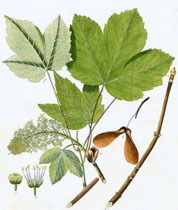 Acer pseudoplatanus. Sycamore has gained a bad reputation as an aggressive weed tree that can prevent native trees such as oak from maintaining themselves. However, recent research has shown that, in the longer term of 200 years or more, sycamore is not really such a bad species, and when planting a new native woodland the Forestry Commission will suggest including some sycamore to help the native species.
Acer pseudoplatanus. Sycamore has gained a bad reputation as an aggressive weed tree that can prevent native trees such as oak from maintaining themselves. However, recent research has shown that, in the longer term of 200 years or more, sycamore is not really such a bad species, and when planting a new native woodland the Forestry Commission will suggest including some sycamore to help the native species.
One real drawback with using this species as a pioneer is that it does not know when to go away and will continue to sow itself around long after the woodland has become established. However, it is still a useful species to use in the right situations, such as near the coast and does have a number of other uses including the sap which can be used to make a sweet drink and the leaves which impart a sweet flavour to food if they are wrapped around the food when baking.
The wood is also of reasonable quality and so perhaps the best way of using this species as a pioneer is to grow it for 10 years or so until the other trees are getting going, and then to gradually remove it over the next few years and utilize the wood.
 Betula species. The Birches are, in general, fast-growing trees that often invade bare land. They will withstand considerable wind exposure, but do not tolerate the most exposed areas, becoming severely wind-pruned in such situations. Like the Alders, they have the benefit of not hanging around too long once they have done what is asked of them, and they do not regenerate well in the shady conditions of a woodland.
Betula species. The Birches are, in general, fast-growing trees that often invade bare land. They will withstand considerable wind exposure, but do not tolerate the most exposed areas, becoming severely wind-pruned in such situations. Like the Alders, they have the benefit of not hanging around too long once they have done what is asked of them, and they do not regenerate well in the shady conditions of a woodland.
Unfortunately they do not have all the other benefits of the Alder, but they can be grown in considerably drier conditions than the alder as well as tolerating areas with periodic inundation. Another disadvantage of the Birches is that their thin branches are blown about in the wind and can act as whips if they are within reach of other trees, this can cause quite noticeable damage.
There are many species in this genus, and any of those that reach tree-size can be tried as pioneer plants, but the native species, B. pendula, the silver birch, and B. pubescens, the downy birch, are particularly recommended. Apart from being superb trees for wildlife, these two very similar species also have a very wide range of uses. These include the sap, which can be taken off in the spring and used to make sweet drinks, beer or vinegar. The bark is very weatherproof and can be used to make drinking vessels, roofing tiles and so forth. A tar-oil is obtained from the white bark in spring which has fungicidal properties and is also used as an insect repellent and a shoe polish. The young branches are very flexible and are used to make whisks, besoms etc. They are also used in thatching and to make wattles. The leaves are a good addition to the compost heap, helping to improve fermentation. This list is far from exhaustive, but does give an indication of the value of these species.
.jpg) Sambucus nigra. The Elder is a wonderfully useful native plant for almost any situation. Whilst it will look rather battered, it will even grow in severe exposure and provide enough shelter to help the woodland trees become established. Unlike many other pioneer species, it will not know when to say goodbye, but will hang around in small numbers, especially along the edges of the woodland. This is a good thing, however, because it does have so many uses both for us and the many other creatures that use it. The fruit is edible, though few people could enjoy it raw. However, it makes a superb preserve and is widely used for making wine. The flowers can also be used in wine-making or as a flavouring in cooked fruits etc., though they can also be eaten raw. So long as you make sure to remove all the insects that are likely to be lurking in the flowers, they make a very refreshing munch on a summers’ day.
Sambucus nigra. The Elder is a wonderfully useful native plant for almost any situation. Whilst it will look rather battered, it will even grow in severe exposure and provide enough shelter to help the woodland trees become established. Unlike many other pioneer species, it will not know when to say goodbye, but will hang around in small numbers, especially along the edges of the woodland. This is a good thing, however, because it does have so many uses both for us and the many other creatures that use it. The fruit is edible, though few people could enjoy it raw. However, it makes a superb preserve and is widely used for making wine. The flowers can also be used in wine-making or as a flavouring in cooked fruits etc., though they can also be eaten raw. So long as you make sure to remove all the insects that are likely to be lurking in the flowers, they make a very refreshing munch on a summers’ day.
There are many other non-food uses of this plant. To mention just one: if you are the sort of person who, when in a group of people are always the first one to be bitten by midges or horseflies then this is the plant for you. Simply rub the leaves over areas of bare skin and the biting beasties will leave you alone for 2 hours or more - then simply top up the dose. You might find that you have a somewhat unique aroma, but you will only get the very occasional bite from a midge that has lost its sense of smell.
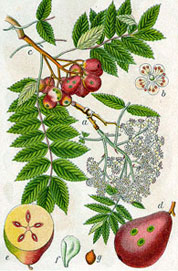 Sorbus species. Several members of this genus make excellent pioneer species. They are in general very wind resistant, though not totally happy in strong maritime exposure when the winds often carry salt. They are also quite tolerant of soil types, though do not like drought conditions and will fare badly in dry soils. Those species particularly recommended are:
Sorbus species. Several members of this genus make excellent pioneer species. They are in general very wind resistant, though not totally happy in strong maritime exposure when the winds often carry salt. They are also quite tolerant of soil types, though do not like drought conditions and will fare badly in dry soils. Those species particularly recommended are:
S. aria. The British native Whitebeam can reach 12 metres in height and is an excellent pioneer on chalk soils, though it is also quite tolerant of other soil types. It is also very tolerant of maritime exposure. The fruit can be eaten raw or cooked it makes a nice jam though most people would not want to eat very many raw. However, it you blett it, which involves storing the fruit in a cool dry place until it is almost but not quite going rotten, then the fruit develops a delicious taste, somewhat like a luscious tropical fruit.
S. aucuparia. Another British native, the mountain ash growsto 15 metres tall and succeeds at higher elevations than any other British tree and so is an excellent pioneer for upland areas. The fruit is very acid and few people would be able to eat more than one - though it makes an excellent jam. This fruit can be used for another purpose - the birds love it and will eat it in preference to apples, with which it ripens at the same time, and so this is a very good plant to grow in or near orchards.
S. decora. The American showy mountain Ash grows to about 10 metres and does well on poor soils. Its fruit is slightly better than S. aucuparia and perhaps could occasionally be eaten raw.
The greedy species
(Those which have aggressive tendencies and are best used in more compact areas such as hedges.)
 Populus species. Many species of Poplar are fast growing and make good pioneers, though most members of the genus will not thrive in very windy sites and all of them are quite aggressively rooting and so do not help to feed the soil or other plants growing in it. They are also rather large trees and many of the species will sucker freely, so they are not suitable for smaller gardens. You need to be careful when planting Poplars near buildings, especially in clay soils, because their root systems can dry the soil and cause subsidence. Poplars usually require a rich soil if they are to thrive and will not do well in drier conditions. Recommended species include:
Populus species. Many species of Poplar are fast growing and make good pioneers, though most members of the genus will not thrive in very windy sites and all of them are quite aggressively rooting and so do not help to feed the soil or other plants growing in it. They are also rather large trees and many of the species will sucker freely, so they are not suitable for smaller gardens. You need to be careful when planting Poplars near buildings, especially in clay soils, because their root systems can dry the soil and cause subsidence. Poplars usually require a rich soil if they are to thrive and will not do well in drier conditions. Recommended species include:
P. alba. The White Poplar will succeed in drier and poorer soils than most members of the genus, and is also quite tolerant of maritime exposure, though it dislikes strong cold winds.
P. balsamifera. The Balsam Poplar scents the air for quite a distance in the spring as its aromatic buds expand. These buds are often used medicinally, their aromatic oils being especially useful in the treatment of chest complaints. In sheltered conditions, try the hybrid ‘TT32’ which can grow 3 metres or more in a year!
P. tremula. The Aspen is a British native species which will grow in poorer soils than most Poplars and is also quite wind tolerant. It will do very well in cold wet soils and, if you get the sub-species P. tremula davidiana it will also succeed in very alkaline conditions. It does sucker freely, however, and so can become a bit of a nuisance.
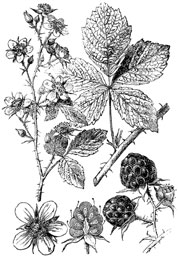 Rubus fruticosus. The British native Blackberry is a species that very often invades cultivated land, and will soon gain a strong hold if left alone for a few years. It usually arrives first as a seed in the droppings of birds or other creatures and then rapidly spreads by forming new roots wherever the tips of the shoots touch the ground. Almost before you know it, there will be dense, impenetrable thickets that spread 2 metres or more in every direction each year. As long as the trees you want to grow there are fairly vigorous, and are allowed to get their heads above the blackberries, then they will normally thrive.
Rubus fruticosus. The British native Blackberry is a species that very often invades cultivated land, and will soon gain a strong hold if left alone for a few years. It usually arrives first as a seed in the droppings of birds or other creatures and then rapidly spreads by forming new roots wherever the tips of the shoots touch the ground. Almost before you know it, there will be dense, impenetrable thickets that spread 2 metres or more in every direction each year. As long as the trees you want to grow there are fairly vigorous, and are allowed to get their heads above the blackberries, then they will normally thrive.
You would not normally introduce this species if you are trying to create an edible woodland garden, but it can be very useful when establishing a native woodland. The dense growth and prickly stems will protect the trees from the predations of deer and rabbits and, eventually, the maturing trees of the woodland will cast lots of shade on the blackberries that, together with root competition, will greatly reduce the vigour of the blackberries, and even eliminate them in places.
Most people know that blackberry fruits are edible, amongst the plants other uses you can eat the young shoots in spring and can also make quite a nice tea from the dried leaves. A fibre obtained from the stems has been used to make twine.
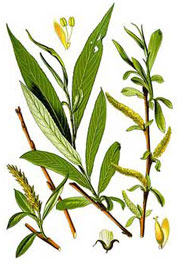 Salix species. There are many species of Willow that can be used as pioneer plants -apart from the first one listed below, only the British native species will be mentioned here. If you do not live in Britain then you would be advised to look at your own native members of this genus in preference to those listed here. Willows are, in general, fast growing trees or shrubs and several species are very tolerant of extreme exposure. They do require a rich soil, though, and will not be very happy unless there is plenty of moisture. Like many other pioneer plants, their seeds are very light and can be carried for considerable distances so they will often find their way to bare sites. They are also quite short-lived, and will not regenerate well once there is shade caused by the developing woodland.
Salix species. There are many species of Willow that can be used as pioneer plants -apart from the first one listed below, only the British native species will be mentioned here. If you do not live in Britain then you would be advised to look at your own native members of this genus in preference to those listed here. Willows are, in general, fast growing trees or shrubs and several species are very tolerant of extreme exposure. They do require a rich soil, though, and will not be very happy unless there is plenty of moisture. Like many other pioneer plants, their seeds are very light and can be carried for considerable distances so they will often find their way to bare sites. They are also quite short-lived, and will not regenerate well once there is shade caused by the developing woodland.
Their main drawback is their extensive root system. This can be an advantage on slopes where the roots will hold the soil together and prevent erosion, there will also be considerable competition with other plants for nutrients.
All the willows mentioned here have similar uses -that is their stems are very pliable and can be used for making baskets etc. Also, the inner bark contains substances from which the painkiller aspirin is made. As an alternative to bought aspirin, you can simply make a tea of the bark - but check with a good herbal book, or an herbalist, before doing this to ensure you get the dosage right.
One of the main advantages of using the willows is their cheapness. They are very easy to propagate by cuttings - you simply stick a bit of stem in the soil and it will root and grow away. Thus you only need to buy a few plants and then take cuttings every winter in order to increase your stock. The recommended species include:
- S. 'Bowles hybrid'. This plant is a male cultivar, and so will never be able to regenerate unless you take cuttings. It grows incredibly quickly to its maximum height of 5 metres, and even in the strongest maritime exposure and will be providing good shelter in its third year.
- S. alba. The white willow will grow quite rapidly and can eventually reach 20 metres or more in height.
- S. aurita. The eared sallow is a very tough creature that is often the first woody plant to invade wetter land and is also useful in reclaiming poor soils. It will only grow up to 3 metres tall, but is exceedingly useful, especially when encouraging natural regeneration of native woodland. Unlike the other willows mentioned here, the stems are of little use for basket making. S. caprea, the goat willow growing up to 10 metres tall, and S. cinerea, the common sallow growing up to 5 metres tall, are very similar species with the same uses.
- S. pentandra. The bay willow will grow up to 10 metres tall.
- S. purpurea. The purple willow will reach about 5 metres tall and is a very good basket willow.
- S. viminalis. The common osier will reach 6 metres in height and can provide an abundance of basket-making material.
You can also see the Woodland Garden Plants leaflet for ideas of things to plant to once you get your woodland going.
Database
The database has more details on these plants: Acer pseudoplatanus, Alnus cordata, Alnus glutinosa, Alnus rubra, Betula pendula, Betula pubescens, Hippophae rhamnoides, Hippophae salicifolia, Lupinus arboreus, Populus alba, Populus balsamifera, Populus tremula, Rubus fruticosus, Sambucus nigra, Salix 'Bowles hybrid', Salix alba, Salix aurita, Salix pentandra, Salix purpurea, Salix viminalis, Sorbus aria, Sorbus aucuparia, Sorbus decora.